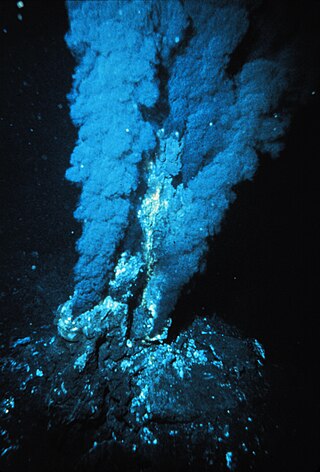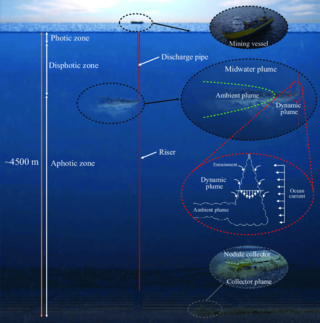
The International Seabed Authority (ISA) is a Kingston, Jamaica-based intergovernmental body of 167 member states and the European Union established under the 1982 UN Convention on the Law of the Sea (UNCLOS) and its 1994 Agreement on Implementation. The ISA's dual mission is to authorize and control development of mineral related operations in the international seabed considered the "common heritage of all mankind" and also protect the ecosystem of the seabed, ocean floor and subsoil in "The Area" beyond national jurisdiction. The ISA is to safeguard the international deep sea, the waters below 200 meters or 656 feet, where photosynthesis is hampered by inadequate light. Governing approximately half of the total area of the world's oceans, the ISA is to exercise oversight of activities that might threaten biological diversity and harm the marine environment. The Authority operates as an autonomous international organization with its own Assembly, Council and Secretariat.

Ore is natural rock or sediment that contains one or more valuable minerals concentrated above background levels, typically containing metals, that can be mined, treated and sold at a profit. The grade of ore refers to the concentration of the desired material it contains. The value of the metals or minerals a rock contains must be weighed against the cost of extraction to determine whether it is of sufficiently high grade to be worth mining and is therefore considered an ore. A complex ore is one containing more than one valuable mineral.

The United Nations Convention on the Law of the Sea (UNCLOS), also called the Law of the Sea Convention or the Law of the Sea Treaty, is an international agreement that establishes a legal framework for all marine and maritime activities. As of May 2023, 168 countries and the European Union are parties.

Polymetallic nodules, also called manganese nodules, are mineral concretions on the sea bottom formed of concentric layers of iron and manganese hydroxides around a core. As nodules can be found in vast quantities, and contain valuable metals, deposits have been identified as a potential economic interest. Depending on their composition and autorial choice, they may also be called ferromanganese or polymetallic nodules. Ferromanganese nodules are mineral concretions composed of silicates and insoluble iron and manganese oxides that form on the ocean seafloor and terrestrial soils. The formation mechanism involves a series of redox oscillations driven by both abiotic and biotic processes. As a byproduct of pedogenesis, the specific composition of a ferromanganese nodule depends on the composition of the surrounding soil. The formation mechanisms and composition of the nodules allow for couplings with biogeochemical cycles beyond iron and manganese. The high relative abundance of nickel, copper, manganese, and other rare metals in nodules has increased interest in their use as a mining resource.

Hydrothermal vents are fissures on the seabed from which geothermally heated water discharges. They are commonly found near volcanically active places, areas where tectonic plates are moving apart at mid-ocean ridges, ocean basins, and hotspots. Hydrothermal deposits are rocks and mineral ore deposits formed by the action of hydrothermal vents.

Law of the sea is a body of international law governing the rights and duties of states in maritime environments. It concerns matters such as navigational rights, sea mineral claims, and coastal waters jurisdiction.

The seabed is the bottom of the ocean. All floors of the ocean are known as 'seabeds'.

Mining in Japan is minimal because Japan does not possess many on-shore mineral resources. Many of the on-shore minerals have already been mined to the point that it has become less expensive to import minerals. There are small deposits of coal, oil, iron and minerals in the Japanese archipelago. Japan is scarce in critical natural resources and has been heavily dependent on imported energy and raw materials. There are major deep sea mineral resources in the seabed of Japan. This is not mined yet due to technological obstacles for deep sea mining.

The National Institute of Ocean Technology (NIOT) was established in November 1993 as an autonomous society under the Ministry of Earth Sciences in India. NIOT is managed by a Governing Council and is headed by a director. The institute is based in Chennai. The major aim of starting NIOT was to develop reliable indigenous technologies to solve various engineering problems associated with harvesting of non-living and living resources in India's exclusive economic zone, which is about two-thirds of the land area of India.

Seafloor massive sulfide deposits or SMS deposits, are modern equivalents of ancient volcanogenic massive sulfide ore deposits or VMS deposits. The term has been coined by mineral explorers to differentiate the modern deposit from the ancient.

Deep sea mining is the extraction of minerals from the ocean floor found at depths of 200 metres (660 ft) to 6,500 metres (21,300 ft). As of 2021, the majority of marine mining efforts were limited to shallow coastal waters, where sand, tin and diamonds are more readily accessible. It is a growing subfield of experimental seabed mining. Three types of deep sea mining have generated interest: polymetallic nodule mining, polymetallic sulfide mining, and cobalt-rich ferromanganese crusts. The majority of proposed deep sea mining sites are near polymetallic nodules or active and extinct hydrothermal vents at 1,400 to 3,700 metres depth. The vents create globular or "massive" sulfide deposits that contain valuable metals such as silver, gold, copper, manganese, cobalt, and zinc. The deposits are mined using hydraulic pumps or bucket systems that carry ore to the surface for processing.

Marine sediment, or ocean sediment, or seafloor sediment, are deposits of insoluble particles that have accumulated on the seafloor. These particles either have their origins in soil and rocks and have been transported from the land to the sea, mainly by rivers but also by dust carried by wind and by the flow of glaciers into the sea, or they are biogenic deposits from marine organisms or from chemical precipitation in seawater, as well as from underwater volcanoes and meteorite debris.

Natural resource economics deals with the supply, demand, and allocation of the Earth's natural resources. One main objective of natural resource economics is to better understand the role of natural resources in the economy in order to develop more sustainable methods of managing those resources to ensure their availability for future generations. Resource economists study interactions between economic and natural systems, with the goal of developing a sustainable and efficient economy.
Nii Allotey Odunton, a mining engineer from Ghana, was the Secretary-General of the International Seabed Authority, serving back to back four-year terms starting in 2009 and ending in 2017. He was succeeded by Michael W. Lodge.
Nautilus Minerals Inc. was a Canadian deep sea exploration and mining company founded in 1997, and listed on the Toronto Stock Exchange between 2007 and 2019. The company was known for Solwara-1, the first deep sea mining project, an attempt to explore and mine a mineral deposit on the seabed off the coast of Papua New Guinea. By 2019, the company had faced bankruptcy and was delisted due to long-standing environmental concerns about the project and financial turmoil, resulting in its assets being owned by Deep Sea Mining Finance Limited.

The Clarion-Clipperton Zone (CCZ) or Clarion-Clipperton Fracture Zone is an environmental management area of the Pacific Ocean, administered by the International Seabed Authority (ISA). It includes the Clarion Fracture Zone and the Clipperton Fracture Zone, geological submarine fracture zones. Clarion and Clipperton are two of the five major lineations of the northern Pacific floor, and were discovered by the Scripps Institution of Oceanography in 1954. The CCZ is regularly considered for deep-sea mining due to the abundant presence of manganese nodules.
Deep Ocean mission is an Indian initiative to undertake the deep ocean exploration focused on India's exclusive economic zones and continental shelf. The program will consist of various crewed and uncrewed submersibles exploring the sea bed. One of the primary aims of the mission is to explore and extract polymetallic nodules, which are composed of minerals like manganese, nickel, cobalt, copper and iron hydroxide. The metals can be used in the manufacturing of electronic devices, smartphones, batteries and solar panels.
The Metals Company, formerly DeepGreen Metals, is a Canadian deep sea mining exploration company. The company is focused on the deep sea mining of seafloor polymetallic nodules.

Namibia is one of the first countries that issued mining licences regarding deep sea mining. studies that took place in 1970s discovered considerable amounts of phosphate deposits. The significance of seabed mining in Namibia's blue economy is highlighted by the country's status as a "phosphate factory". This is due to the exceptional upwellings of the Benguela Current ecosystem, a transboundary ocean current that spans from South Africa in the south to Angola in the north, passing through Namibia. Those deposits were found in depths between 180 and 300 meters below the sea level. In 2011 the Namibian government issued licences regarding the exploitation of the seabed phosphate resources after the necessary Environmental Impact Assessments (EIAs). The action plan that stood out was that of Namibian Marine Phosphates (NMP), a joint venture formed in 2008 between two Australian-based companies, Minemakers and Union Resources and Namibian-based Tungeni Investments. The so-called Sandpiper phosphate mining project outlay was introduced in January 2012 along with environmental reports regarding the effect this operation would have on marine life as well as the fishing industry and water quality changes. Those phosphorite resources are being found in continental shelves and slopes in America, Northern Spain, Morocco, Namibia, and South Africa which show a high potential for exploration.
On the 25th of June 2021, the president of Nauru, Lionel Aingimea, made a formal request to the president of the International Seabed Authority's (ISA) council to complete the adoption of rules, regulations and procedures necessary to facilitate the approval of plans of work for exploitation of deep-sea resources in the Area. This request is based on the "2-year rule", which is part of a provision from the 1994 Agreement relating to the Implementation of Part XI of the United Nations Convention on the Law of the Sea. The provision can be found in section 1 of the annex, and it states that the ISA must complete the adoption of rules, regulations and procedures for the approval of the exploitation of deep-sea minerals within 2 years of the request. The ISA's current deadline for drafting new regulation is set in July 2023, although some claim that this is not a "hard" or "fixed" deadline. Due to the issue's complexity, negotiations have thus far failed to come to a concrete agreement. Even if it fails to set clear standards for deep-sea mining activities, the ISA must consider applications for exploitation in waters outside national jurisdictions and provisionally approve contracts after July 2023. Many experts fear that deep-sea mining activities that are not adequately regulated could significantly impact the marine environment, the economies of many nations and the livelihoods of indigenous groups who depend on the oceans for survival.















